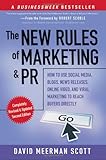The New Rules of Marketing and PR: How to Use Social Media, Blogs, News Releases, Online Video, and Viral Marketing to Reach Buyers Directly (New … & PR: How to Use Social Media, Blogs,)
- New
- Mint Condition
- Dispatch same day for order received before 12 noon
- Guaranteed packaging
- No quibbles returns
A completely revised and updated edition of the BusinessWeek bestseller on effective, modern marketing and PR best practices The New Rules of Marketing and PR shows you how to leverage the potential that Web-based communication offers your business.
List Price: £13.99
Price: [wpramaprice asin=”0470547812″]
[wpramareviews asin=”0470547812″]
[wprebay kw=”internet+marketing” num=”6″ ebcat=”-1″] [wprebay kw=”internet+marketing” num=”7″ ebcat=”-1″]




A good read if you are new to internet. That’s all there is to it.,
If I get one good idea from each book I read, I’m quite happy.
This book truly has some good ideas like an analysis of the most over-used and under-meaningful phrases in PR. But apart from a handful of nice-to-knows this book is really disappointing. Too many pages for too few need-to-knows.
This book is probably good for newbies to online (and social) media (i.e. they who don’t know what a blog is), but I certainly cannot recommend it for “advanced users”.
For the former it’s a nice kickstart, for the latter it’s merely an overview of what you already know and hence a waste of precious time.
Was this review helpful to you?

|A quick read about how the Internet has changed marketing and PR practices,
David Meerman Scott asserts that the Internet has transformed marketing and public relations forever, and he’s undoubtedly got a point; however, his argument is extremely light on facts and figures (the text contains hardly any numbers at all), and heavy on case studies. Based on Scott’s blog, the book is anecdotal, chatty, easy to read and occasionally repetitive. Scott is an evangelist for using the Web in new ways, and his ideas are useful and practical. getAbstract recommends this book to experienced marketers who are unfamiliar with or skeptical of new media and techniques; younger readers may find it superficial or obvious.
Was this review helpful to you?

|New lamps for old,
There are some real gems and lots of good, solid, practical insights in this book. And I have to admit after some initial scepticism, this book is the first to provide me with real insight into how the Web, and blogging more specifically, can be used to aid PR and marketing strategies.
This said, I found Scott less good with the underpinning theory; he has a tendency to make a few too many assumptions and is a bit too loose with the generalisations. This isn’t necessarily a bad thing in itself, as it can make the writing `pacy’ and accessible. However, I would certainly take issue with the way he defines marketing. It’s a pretty one-eyed view, and to make matters worse its advertising he focuses on in the list he draws up detailing its shortcomings. At the best of times resorting to `man of straw’ arguments is dubious rhetoric, and initially this made me doubt the book’s `authenticity’ or thought leadership, as Scott would perhaps call it.
I would also argue that `interruption advertising’ still has its place both of itself and when integrated into Web-based strategies. The creative variations of Cadbury’s `Gorilla’ advertisement on YouTube offer an intriguing insight to what can be achieved.
The issue I have with Scott’s book is, that to begin, he is so concerned to argue the old marketing and PR rules are dead, that he dilutes the message about how the old and the new might be better integrated to deliver more effective communications, at whatever level of access. But by the end of the book, his more measured, thoughtful and practical approach had turned me around.
For me, Scott sums up his book in the following statement. The new publishing model on the Web is about. . . delivering content when and where it is needed and, in the process, branding you or your organization as a leader. When you understand your audience, those people who will become your buyers, you can craft an editorial and content strategy just for them. . . . In order to implement a successful strategy, think like a publisher.
Two final comments: understanding your audience is classic, `old marketing’. Secondly, thinking like a publisher is not exactly easy, but it’s what conventional PR attempts to achieve when crafting messages for its audiences. So, let’s be careful not throw out the baby with the bath water.
Was this review helpful to you?

|